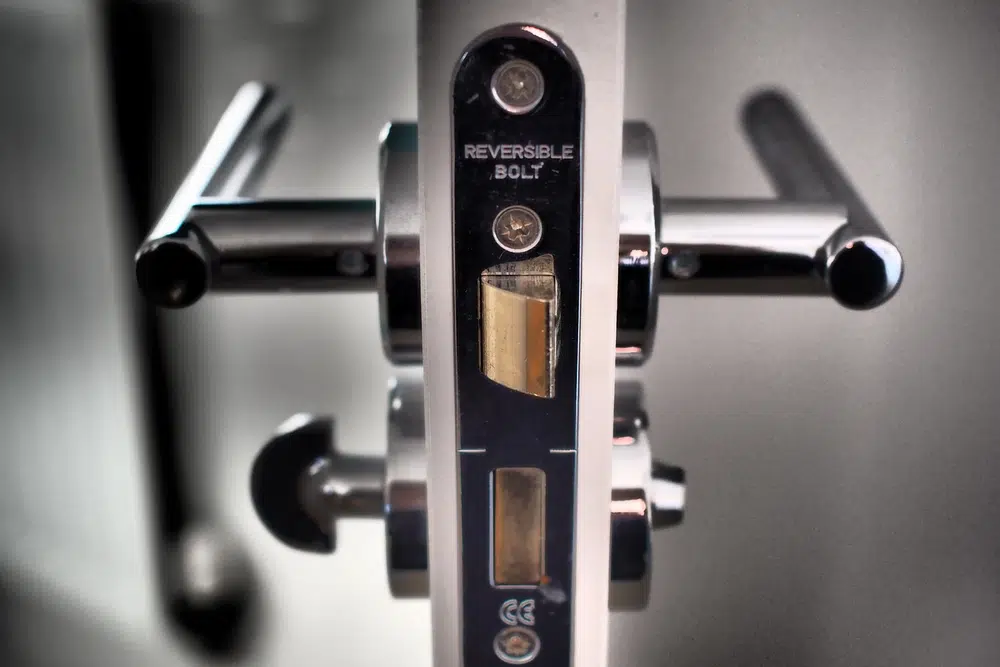The 4 door lock types to know about

Choosing between door lock types can be tricky. You want the lock to provide security, longevity and aesthetic appeal — after all, it’s something you’ll have to look at almost every day.
We’ll take you through the different types of door locks so that you can find something safe, secure, and striking.
Fast facts about door locks
Before we get started, let’s look at some door lock facts that are handy to know:
The British Standards Institute (BSI) gives the code BS3621 to thief-resistant locks, which are typically used for front and back doors. You’ll know you have one of these locks if you can see the stamp of this code on the visible, outward-facing part of the lock.
Many insurance providers require your locks to have the BSI stamp of approval. Some may also require that you have a certain type of lock that they deem even more secure.
The lock you choose will depend on the material of your door and whether it’s an internal or external door (more on this below). So there’s no “best” lock type — it really depends on your needs.
What are the different types of door locks?
There are four major types of door locks:
Mortice lock
Multi-point locking system
Euro cylinder lock
Rim automatic deadlatch
We’ll take you through the details of each, their pros and cons, and what type of door they’re best suited to.
What are the 4 major types of locks?
Mortice lock
A mortice lock is a common back and front door lock type. It’s an older form of lock that’s been around since the 18th century but is still very much in use today. Here’s what you need to know about it.
[Note to Howden: Image link for mortice lock]
Description
First, a mortice is a pocket. A mortice lock is a kind of lock that is fitted into a “pocket” or specially carved-out hole in a door.
Because this lock type fits inside a door rather than on top of it, it has a smooth, sleek aesthetic. It is typically installed in wooden doors as other kinds of materials, like aluminium and unplasticized polyvinyl chloride (UPVC), make it difficult to install the pocket. (If you’re wondering, UPVC is a safe building material commonly found on newer doors and windows. It’s popular because it’s low maintenance, durable, and cheaper than hardwood and aluminium.)
Unlike other kinds of locks, a mortice lock needs a key inserted into it to open.
A common type of mortice door lock is the 5-lever mortice deadlock. When you place the key into the lock, five levers move into position so that the lock can be turned. You will know that it’s a 5-lever, rather than a 3-lever, lock because this information will be stamped onto the front of the lock.
So that’s the 5-lever part of the equation — but what is a deadlock? Basically, it means the lock can be opened on both sides, but you need a key to do so when it’s in deadlock mode. This provides extra protection for your home. Nobody is getting in or out unless they have the right key.
Because the 5-lever mortice deadlock is so secure, many insurers may make having one on your door a condition of your insurance.
Advantages
High security
Insurance approved
Sleek aesthetic
Customizable for larger and smaller doors
Strong and durable
Disadvantages
Installation is a bit more tricky — remember, you have to get a pocket (or mortice) into the door to fit the lock
Difficult to open if a key is stuck on the other side of the door
Older forms of the lock are less secure
Euro cylinder lock
This very common door lock is also known as a euro lock barrel.
[Note to Howden: Image link for euro cylinder lock lock]
Description
In a euro cylinder lock, the cylinder in question is the part of the lock where the keyhole is housed. You insert your key into the cylinder, turn it, and if it’s a match for the mechanism inside, the lock will turn. A cylinder lock is a versatile system used on everything from doors to padlocks.
So what about the “euro” part?
A euro cylinder lock is also known as a kind of pin tumbler lock (more commonly known as a Yale lock by its famous brand name and inventor).
It’s called a pin tumbler because different-sized pins are used inside the cylinder, and when the edges of the right key come into contact with the pins, the patterns match up, and the door is opened. Magic.
Some locks have five pins, others six. The more pins, the harder the code is to crack and the more secure your door is.
What’s particularly great about the euro cylinder lock is its versatility. You don’t have to build any hardware into the door itself. As a result, it works in a wide range of building materials, from wood and steel to aluminium and UPVC. It can also be used on both interior and exterior doors.
Euro locks are further divided into:
Half euro cylinder lock: Key access is available from one direction only.
Double euro cylinder lock: Key access is available from either side.
Thumb turn cylinder lock: Opened with the turn of your thumb on one side and either a keypad or key mechanism on the other.
Anti-snap euro cylinder lock: Specially designed to prevent “lock-snapping” — a technique of breaking a lock open by force. Anti-snap locks have a security “snap line” that will be sacrificed before your security is.
Advantages
Simple to use
Versatile
Easy to install and modify
Relatively inexpensive
Disadvantages
At the risk of falling prey to lock snapping if it doesn’t have anti-snap technology in place
If it’s not stamped by the BSI, your door could be particularly vulnerable
Multi-point locking system
Another common external door lock, the multi-point locking system is a good option for front and back doors, as well as French doors and patio doors. It’s a more modern form of lock that has various advantages.
[Note to Howden: Image link for euro cylinder lock lock. No images are available on Adobe for this lock. Can we use an image from this article and credit it?]
Description
As the name suggests, a multi-point locking system locks in multiple places within its system. It usually has a euro cylinder lock on the outside of the door that your key will be inserted into and a multi-point locking system inside to keep it really secure.
When you turn the key in the lock, it engages between three and five bolts. Because the pressure is not only on one locking point, the lock tends to be more durable and has a longer life than single lock options.
A multi-point locking system is typically found in UPVC and composite (made from more than one material) doors, but it can also be fitted to aluminium and wood doors.
Like a mortice lock, a multi-point locking system is popular with insurance companies because it provides excellent safety and security for homes and businesses.
It also boasts a sleek finish because the locking mechanisms are inside the door rather than outside. The downside is that it may be tricky to install this lock type on an existing door as it might be difficult to get it to match up accurately. (The good news is, once you do have a multi-point locking system, it’s easy to upgrade to a lock of a similar type.)
Another potential drawback? There can be a learning curve. Until you get the hang of locking this type of lock properly, you may not completely lock your door, leaving your property vulnerable to intruders.
Advantages
Safe and secure because of all those locking points
Easy to use — only one key for all that security
Insurance recommended
Durable and long-lasting
Easy upgrades and changes to similar lock type
Disadvantages
Difficult to install on an existing entry door
Can be more expensive than single-point locks
If you don’t know how the lock operates, it’s possible you won’t lock it completely
Rim automatic deadlatch
If you’re browsing through internal lock types, you’re likely to find the rim automatic deadlatch as a top option. Here’s what you need to know.
[Note to Howden: Image link for rim automatic deadlatch. No images are available on Adobe for this lock. Can we use an image from this article and credit it?]
Description
Like the euro lock, the rim automatic deadlatch, or night latch, uses a cylinder on one side of a door linked to a keyhole on the other. This lock type is most commonly used on timber and glass-panelled doors.
While mortice locks are fitted within a door, the rim automatic deadlatch fits on the surface of it, providing easier installation but less of a sleek aesthetic.
Unlike a deadlock, which requires a key to open, a deadlatch locks automatically when the door closes. While this means you won’t be leaving your door unlocked, it may also mean that there is a chance you could lock yourself out.
Rim automatic deadlatches are often used in conjunction with mortice locks for extra security.
Advantages
The door locks automatically — no forgetting to lock your door
Easy to install
Disadvantages
Might need another lock (like a mortice deadlock) for added security
Can lock yourself out by accident
How do I know what lock fits my door?
Start by asking yourself the following door lock questions:
Is it an internal or external door? Front doors and back doors are well served by mortice and multi-point system locks, while rim automatic deadlatches are better for internal use.
What material is my door made of? Mortice locks are more suitable for wooden doors, but a multi-point locking system is more appropriate for UPVC and aluminium.
What sort of aesthetic am I after? If you’re after a sleek design, a mortice or multi-point locking system is best.
Do I have help with installation? Locks that must be fitted inside the door rather than on top of it require more expertise to install.
How much security do you need? If safety is a priority, it’s essential to go with a lock with the BS3621 stamp of approval.
How much money do I have to spend? Not all locks are priced equally. It is worth considering, though, that more expensive locks tend to be more durable. They may also be more secure — which could save you from the expenses of a break-in.
You may also want to engage the services of a professional locksmith, as not getting a lock done correctly can cost you down the line.
Quickfire summary
Finding the right lock to fit your door is important for a range of reasons, from keeping your property safe and secure, to maintaining the aesthetic of your home or business.
There are four main lock types available:
Mortice lock: Good security for front and back wooden doors.
Euro cylinder lock: A simple-to-use versatile lock fitted on the exterior of a door.
Multi-point locking system: Good security for front and back doors of various materials, such as UPVC and aluminium.
Rim automatic deadlatch: An easy-to-install option that’s typically fitted on the exterior of internal doors
Give us a shout if you need to chat through the insurance implications of your choice.
Also read:


